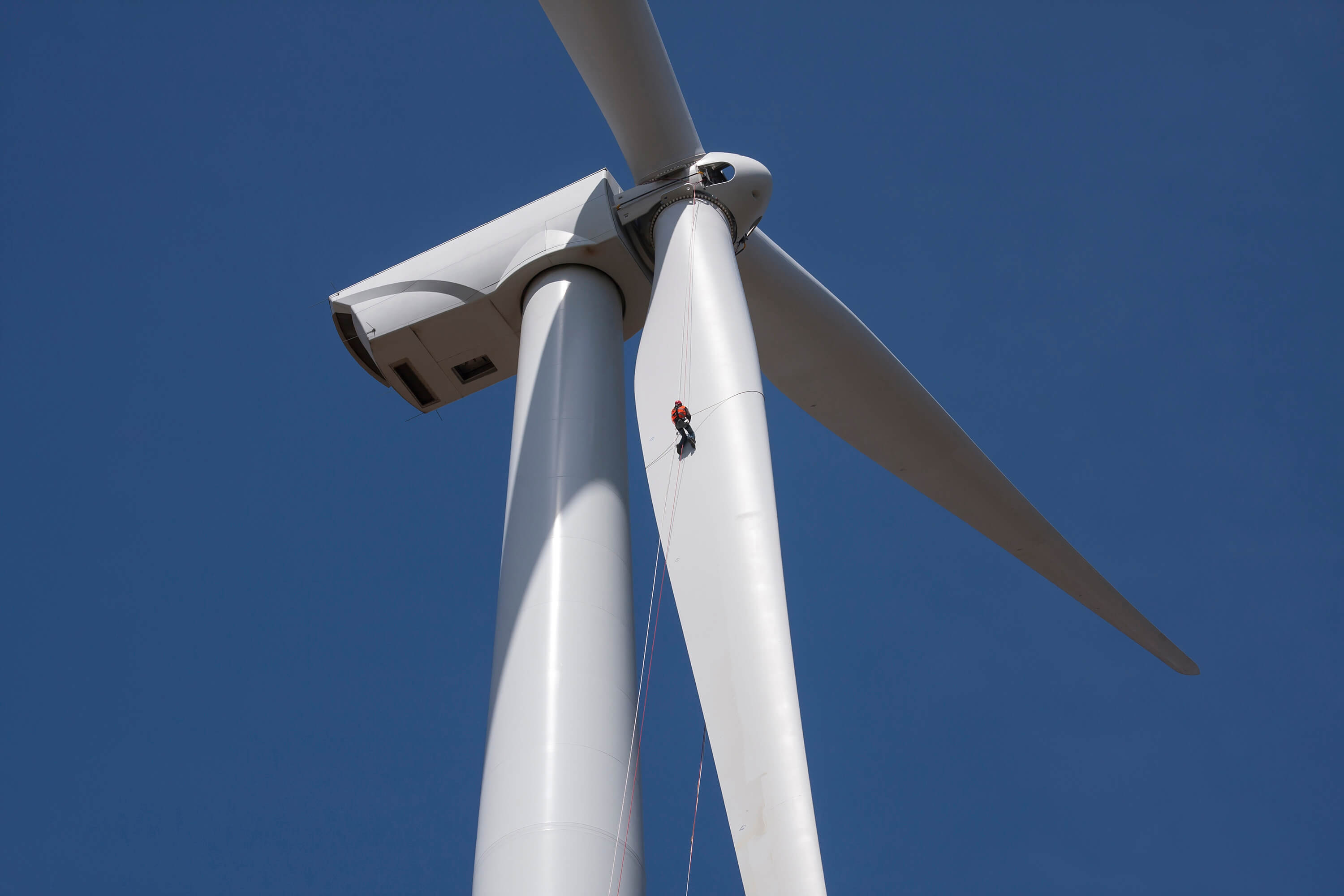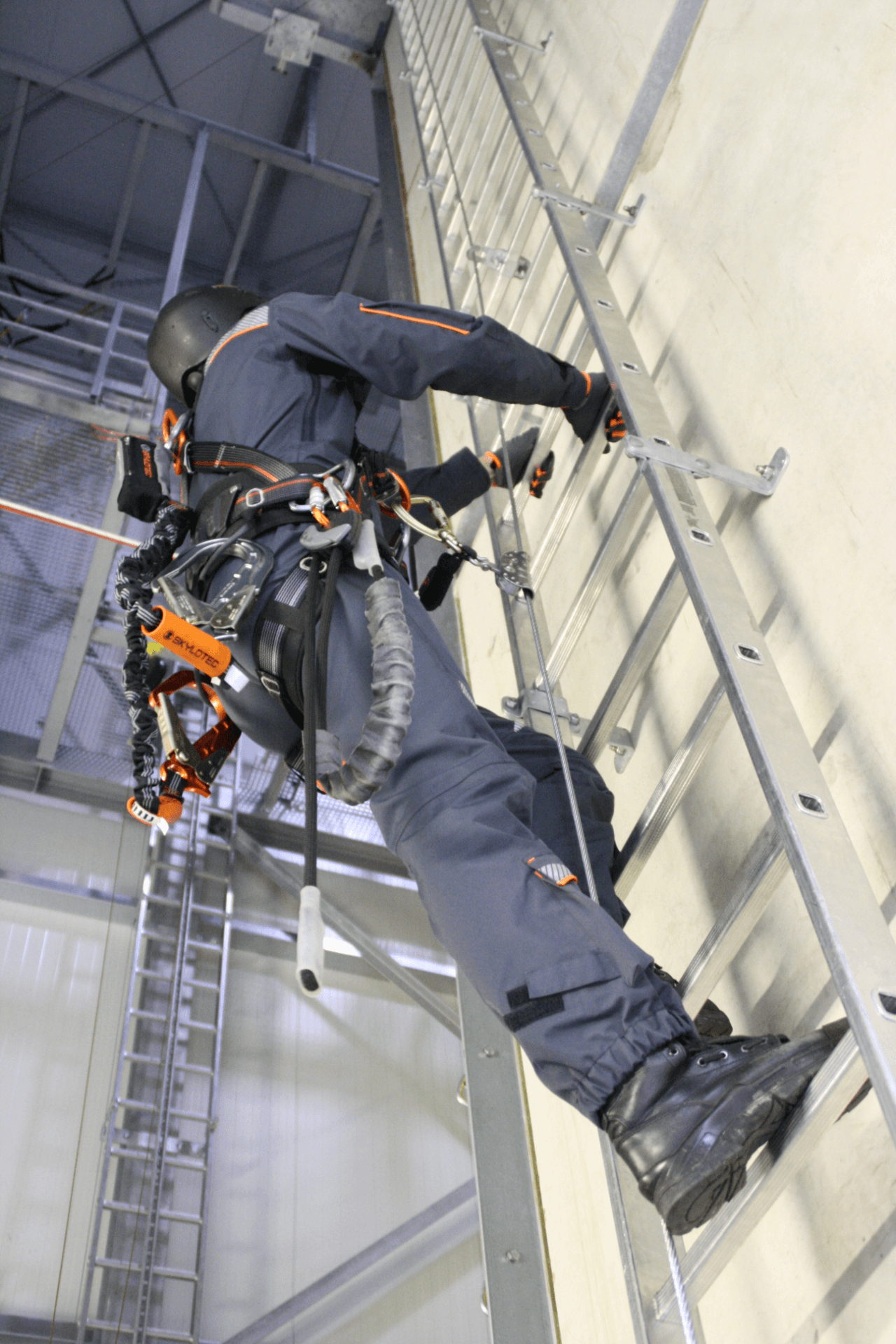Written by Mark Del Franco
Freelance writer

The effectiveness of fall-protection gear, no matter how durable or reliable, is at risk when workers fail to use it correctly. That’s why contractors or wind operators should enlist a training program to ensure technicians working at height use equipment properly and safely.
In an ideal world, every wind technician would be outfitted with a lightweight fall-arrest system weighing less than five pounds. Such a system would easily attach to the tech’s harness without entanglements or encumbrances during climbs.
“The issue with a fall-arrest system is that it hangs off of you,” explains Neal Gyngard, founder of TCGM, a network of wind-turbine technicians. “It needs to be integrated in a way that prevents it from getting hung up or hitting a worker’s legs and backside during a climb.”
Although safety gear has improved over the years and manufacturers continue to make advancements, there is no one-size-fits-all product on the market that suits each technician. “At the end of the day, the industry is working with the same basic concepts,” Gyngard says. “We’re still dealing with rope. How durable can we make rope? How flame-resistant can we make it?”
If you’re looking to make some improvements to your company’s fall-protection program, consider the following tips:
- Watch your weight. The top complaint lodged by wind technicians is hauling excessive or needless weight when making repeated climbs, according to Gyngard. “Plain and simple, nobody wants unnecessary weight in their bags.”
- Know your equipment. This may sound obvious, Gyngard admits. However, a technician who is unfamiliar with his or her safety equipment during a fall arrest is a safety concern. Gyngard says it is important to take safety equipment to the project site when possible and practice using it before the job begins. “Also, buy your team whatever they will use and let them work with it often to stay familiar with it.”
- Experience controlled descent. This means letting techs practice repelling out of a turbine tower. “There is nothing like real-life training,” Gyngard advises. “Bite the bullet on liability and give techs supervised emergency evacuation training that they need.”
- Consider costs. Further complicating matters is the economics and investment companies need to make in fall-protection systems. For example, is the wind operator or contracting company going to pay for the safety gear and necessary training?
The most important part of any safety program is communication. Do the technicians know what to do during stressful situations? Are they familiar with their equipment? Safety is imperative. It is important to know their level of skill and training.
A new approach
While the wind industry relies on its mainstays, Gyngard notes some new approaches to fall-arrest systems could soon hit the market.

The SKYLOTEC CLAW Vertical Fall-Arrest Sleeve fits a wide variety of solid core wire ropes and travels smoothly along the vertical system, providing fall arrest if needed.
“I saw a backpack with a cable spool that looked interesting,” he says, adding that the Israeli company also sells the same product to the military and its special forces.
Some manufacturers are experimenting with dynamic loads. An interesting approach, he adds, but one with limitations. “Controlled decent devices work well when the rope is vertical,” says Gyngard. “When the rope angle is changed, it becomes more difficult to descend.”
Putting safety first
When the job requires wind techs to work hundreds of feet above the ground, safety is the name of the game. Here’s a brief look at some of the fall-arrest systems and equipment typically used by the wind industry.
SKYLOTEC’s CLAW is a fall-arrest system designed to simplify use and reduces the risk of an accident. Thanks to double-safety construction and an integrated locking mechanism, SKYLOTEC says the CLAW also prevents incorrect installation. In addition, a skull symbol indicates incorrect installation while an “UP” arrow identifies proper installation. If the climber slips or falls, the CLAW activates and locks onto the cable, arresting the fall within inches.
Tractel offers numerous fall-protection products such as BLOCFOR self-retracting lifelines and STOPFOR rope grabs. According to Tractel, the BLOCFOR provides freedom of movement to the worker performing their job, while automatically locking the rope in the event of a fall.
ENSA North America’s assisted-rescue and personal evacuation system (or APE, for short) provides an all-in-one rescue solution that is lightweight and economical. According to ENSA, the APE is positioned at or below the waistline, like a fanny pack, and is designed to integrate with the majority of fall-arrest harnesses currently on the market. According to the company, the APE provides the user with the ability to immediately affect a self-rescue or a rescue of a co-worker.
Tech Safety Lines, a global rescue solutions provider, offers third-party certified micro rescue kits that allow each worker the ability to perform a self and assisted rescue in the event of a fall from height. The company’s patented fall-arrest lanyard, the StepWise, has a webbed ladder built into the shock pack that provides relief from suspension trauma when deployed. This same lanyard also has an anchor point that can be used in conjunction with Tech Safety Lines self-rescue kit, allowing the fallen worker to perform a true self-rescue after a fall.
Filed Under: Featured, Uncategorized





Hello Mark,
I am trying to find the Master Spec section for fall arresters in fixed ladders. Do you know if there is one?
Thank you